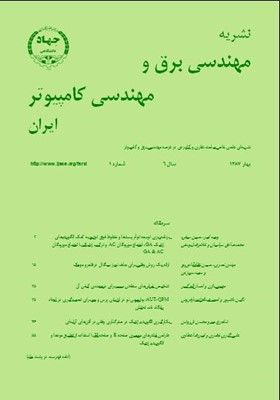شبيهسازی انتشار امواج رادیویی از درون سازههای پنجرهای با استفاده از روش TLM
محورهای موضوعی : مهندسی برق و کامپیوتررمضانعلی صادقزاده 1 , عباسعلی لطفی نیستانک 2 * , محمد جهانبخت 3 , محمدناصر مقدسی 4
1 - دانشگاه خواجه نصیر الدین طوسی
2 - پژوهشکده برق جهاد دانشگاهي
3 - پژوهشکده برق جهاد دانشگاهي
4 - دانشگاه آزاد اسلامی واحد علوم و تحقیقات تهران
کلید واژه: انتشار امواج رادیوییروش ماتریس خط انتقالسازههای پنجرهای,
چکیده مقاله :
در این مقاله، روش عددی ماتریس خط انتقال (TLM) برای شبیهسازی انتشار امواج رادیویی از درون ساختارهای پنجرهای مورد استفاده قرار گرفته است. در شبیهسازی یک پنجره با ابعاد مشخص یا مجموعهای از پنجرهها در حالتهای گوناگون مورد ارزیابی قرار میگیرند و مسئله انتشار امواج رادیویی در هر حالت جداگانه بررسی خواهد شد. اثر تغییر ابعاد، جنس پنجرهها و همچنین زاویه تابش موج صفحهای به تفصیل بیان شده است و در هر مورد، نتایج با سایر روشهای عددی نظیر روش تفاضل محدود ، مرور اشعه و اجزاء محدود مقایسه شده است که نتایج حاکی از دقت خوب روش TLM میباشند. به علاوه، نتایج شبیهسازی در یک مورد با نتایجی که عملاً اندازهگیری شده، مورد قیاس قرار گرفته که از این لحاظ نیز صحت مدلسازی تأیید شده است.
In this paper transmission line matrix method is used to simulate the wave propagation through window structures. In this analysis a single window with precise dimensions and also a group of windows are considered. The effect of window’s dimension, window’s material, and angle of incidence are all evaluated in details and in each case, the method has been compared with other numerical results, such as FDTD, ray tracing, and finite element methods. Furthermore, in one case the implementation of TLM method was shown to have a good agreement with the measured values.
[1] S. Ichitsubo, T. Furuno, T. Taga, and R. Kawasaki, "Multipath propagation model for line-of-sight street microcells in urban area," IEEE Trans. Veh. Technol., vol. 49, no. 2, pp. 422-427, Mar. 2000.
[2] G. E. Athanasiadou and A. R. Nix, "Investigation into the sensitivity of the power predictions of a microcellular ray tracing," IEEE Trans.Veh. Technol., vol. 49, no. 4, pp. 1140-1151, Jul. 2000.
[3] W. Zhang, "Fast two-dimensional diffraction modeling for sitespecific propagation prediction in urban microcellular environments," IEEE Trans. Veh. Technol., vol. 49, no. 2, pp. 428-436, Mar. 2000.
[4] Z. Ji, B. H. Li, H. X. Wang, H. Y. Chen, and T. K. Sarkar, "Efficient ray - tracing methods for propagation prediction for indoor wireless communications," IEEE Antennas and Propagat. Magazine, vol. 43,no. 2, pp. 41-49, Apr. 2001.
[5] L. Talbi, "Indoor UHF propagation modeling using FDTD," IEEE AP-S International Symposium and USNC/URSI National Radio Science Meeting. Boston, Mass., 2001.
[6] Z. Zhang, R. K. Sorensen, Z. Yun, M. F. Iskander, and J. F. Harvey, "A ray-tracing approach for indoor/outdoor propagation through window structures," IEEE Trans. Antennas Propagat., vol. 50, no. 5,pp. 742-748, May 2002.
[7]ن. نوري و ه. عريضي، "مدل سازي انتشار امواج راديويي از درون ساختارهاي پنجره اي با استفاده از روش معادله سهموي،" پذيرفته شده براي نشريه مهندسي برق و مهندسي كامپيوتر ايران.
[8] R. Hoppe, P. Wertz, G. Wolfle, and F. M. Landstorfer, "Wideband propagation modeling for indoor environments and for radio transmission into buildings," in Proc. Personal, Indoor and Mobile Radio Communications, PIMRC 2000, vol. 1, pp. 282-286, 2000.
[9] R. Scaramuzza and A. J. Lowery, Hybrid Symmetrical Condensed Node for the TLM Method, Electronic Letters, vol. 26, no. 23, Nov. 1990.
[10] C. Christopoulos, The Transmission-Line Modeling Method, IEEE Press, 1995.

